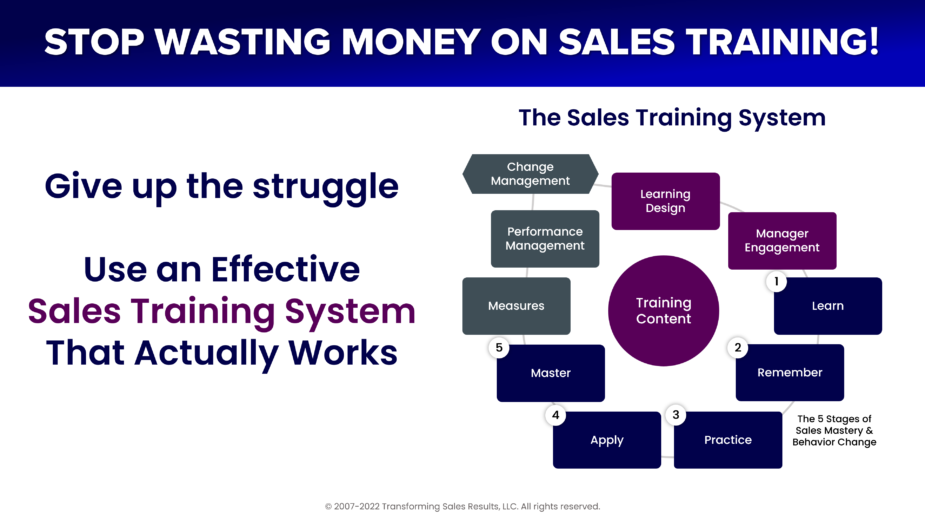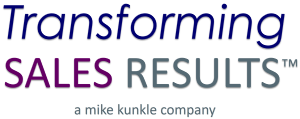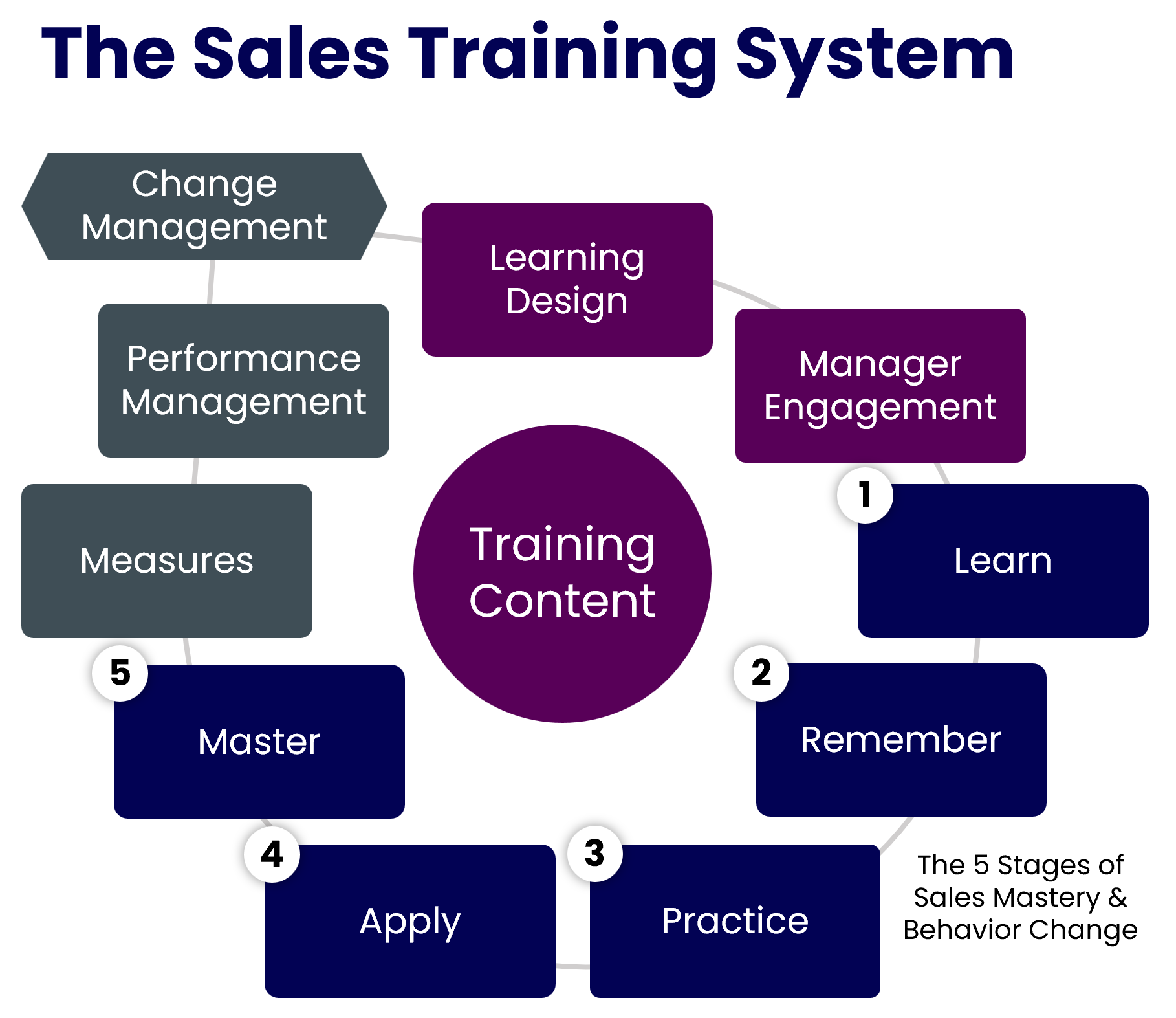Stop Wasting Money on Sales Training

If I hear, “Sales training doesn’t work” one more time, I think I’ll scream.
If done well, sales training works fine, for what it’s designed to do. This may spark a semantics debate, especially with my friends in the sales consulting space and others with a performance-orientation, but to me, training – in and of itself – is not designed to improve performance. On any given topic, training teaches people:
- WHAT to do
- WHY to do it
- Especially HOW to do it
- And possibly WHEN and/or WHERE to do it, if those nuances matter.
Training, done well, simply provides the knowledge and skills that are required to do a task or job. It provides the potential to improve performance, though, if an employee hasn’t currently mastered the tasks and job. And, of course, that presumes you can get the employee to actually do what they’ve been taught.
As with any knowledge or skill, knowing what to do and being able to do it, does not automatically mean that the knowledge and skill will be used, or performed well. The “Knowing/Doing Gap” is legendary, and books have been written about it.
Don’t Hear the Wrong Message
As a friend of mine is fond of quipping, “Please don’t hear what I’m not saying.” It’s not that I believe we shouldn’t focus on improving performance – we should, and it’s been my life’s work. We just need to stop putting unrealistic expectations on training alone to do it.
Training is only PART of the solution. Knowing what, why, how, when/where to do something, is not enough. And that’s where training’s responsibility ends. (“Training” in that sentence means the act of training, not the department or function leaders, who should be consulting internally with their clients to use training effectively like this, to improve performance.)
You’ve probably surmised by now that I DON’T really mean that we should stop training. I DO think that we should stop wasting money by doing it poorly. I DO mean that we should stop JUST training and expecting performance results.
Make an Impact with a Sales Training System
So how DO we improve sales performance? Well, there are dozens of ways to attack the sales performance ecosystem (also see this post) but when a knowledge or skill gap is involved, we should use training, implemented with a Sales Training System.
We could debate whether this is a “performance” system rather than “training,” but I chose training because there are many non-training ways to address performance issues… this method applies when training/learning is part of the solution.
As you see, The Sales Training System includes training, and much more:
- The right Training Content that will produce results when used
- Effective Learning Design with a learning experience that fosters course completion, learning, and retention
- Extensive Manager Engagement that fosters buy-in, engages, empowers, and enables front-line sales managers to support the training
- Purposeful plans to support retention and help reps Remember what they’ve learned
- Intentional Practice opportunities, with feedback loops, to develop comfort with new skills
- Purposeful plans to help reps Apply what they learned and transfer new skills to the workplace
- Ongoing coaching from sales managers to guide reps toward sales skill Mastery, over time
- Measurement plans that help you track progress toward mastery, or learn where to pivot
- Aligned Performance Management practices to ensure reps and managers are help accountable
- An integrated, aligned, Change plan to cement new behaviors into the culture to become “the way we do things around here”
So what is the difference between training alone and an effective Sales Training System?
Training typically includes just Content and Design (with perhaps a smidgen of a few others, but often not). If you’re an ADDIE fan, training involves Analysis, Design, Development, Implementation and Evaluation. Today, we’re hearing a lot about agile methods like the Successive Approximation Model (SAM), which is worth looking into, but you can use either in the Design phase here.
I hope it’s obvious that the elements that truly drive results in an effective Sales Training System go far beyond training.
Due to space limitations, this will be brief, but will give you the flavor of this methodology.
The Right Training Content
The best training or learning system in the world can’t overcome poor content that won’t produce real-world results when used. When training is the right solution, it all starts here. Training pros will all be familiar with needs analysis, by it’s many names (needs, gaps, and/or front-end analysis), and I strongly encourage Top Performer Analysis when possible, to find the differentiating practices between top sales performers and middle performers.
An Effective Learning Experience with Sound Instructional Design
There is a big difference between presenting information and designing effective training. Much is written on this topic, especially ADDIE, and I have a presentation on Basic Instructional Design Principles on SlideShare, as well. You should also check out the Successive Approximation Model. Whichever methods you use, my brief recommendation here would be:
- Chunk, sequence and layer the content, and assess frequently.
- Separate knowledge and skill and blend the learning (knowledge prerequisites, possibly elearning or virtual instructor-led training) with classroom or virtual skills-based training (with much practice and feedback loops).
- Use as many simulations as possible to model the real-world and teach how knowledge and skills plug into process and workflow, in-context. (Just like when teaching Microsoft Word… don’t just teach the menus, teach the workflow of how to build a document).
- Consider working backward from your evaluation strategy, so you build the training necessary to deliver the results you need. See this post for additional information on this.
Sales Manager Engagement
The goal here, as mentioned, is to foster buy-in, engage, empower, and enable front-line sales managers to support the training. You should engage front-line sales managers as much as possible, based on the organizational tolerance for it, which will create natural limits. Some examples:
- Sales Managers were often the best salespeople, so they’ll have great content feedback as Subject-Matter Experts.
- Sales Managers need to have buy-in for the content and support it enthusiastically with their reps.
- Sales Managers need to understand the content and know what their reps are learning and how to best reinforce and coach it.
The 5 Stages of Sales Mastery & Behavior Change
Learn:
- Here, you simply execute the training plan, holding learners accountable for completing the training, and perhaps assessing along the way.
Remember:
- There are multiple tactics you can use to foster retention. Spaced repetition works well, as does retrieval learning. Post-training manager-led reinforcement meetings can take advantage of both of those, as well as reinforce through ensuring the understanding of the context, putting it in context, and through discussion.
Practice:
- For skills training there is no better option than role play, simulations, and deliberate practice. This can be done in multiple ways, and also through the same post-training manager-led reinforcement meetings mentioned above.
Apply:
These are purposeful transfer plans. How do you plan to get training out of the classroom and used on the job? This is where most training fails. Consider:
- Providing job aids and worksheets to aid reps in preparing to use what they’ve learned with buyers and customers.
- Completing these forms and preparing to use them, during the manager-led reinforcement sessions.
- Having sales managers follow-up and observe skills in action. Ride-alongs or call-alongs with coaching are very effective for this, but when managers cant attend to observe live, they can review call recordings or conversation intelligence analyses to ensure skills are being applied, and how we’ll they’re being used.
- Building training content into Sales Enablement applications/tools, CRM, and process workflow, makes great sense. Guided selling tools and workflow performance support tools are advancing and becoming more popular and reinforce not just sales process but also sales methodology. Do everything you can to turn the top-performer practices in your training into “the way we do things around here.”
Master:
This applies generally as well as in this training system. Good evaluative, developmental, and behavior-based coaching skills are required for sales excellence. If I need to convince you about this, you’re reading the wrong post. Some ideas:
- Coaching on using the skills taught (activity) and how well the skills are being used (quality) are a key part of the above transfer plans – but even after the skills have transferred, coaching will sustain and grow the skills.
- Sales Managers already should understand the content, but also need to know how reporting and analytics indicate gaps in the top-performer behaviors that were taught, and how to coach to close those gaps.
- There is much support that can be provided to Sales Managers here. While managers are generally sharp business pros, we shouldn’t assume that everyone will make the dot-connections on their own. You can provide support materials to help them reinforce the training with reps, training on how to diagnose gaps, and how to coach as effectively as possible (and separately, how to manage and lead their teams and exceed at other aspects of their complex and difficult role).
Measurement Plans
This addresses what success will look like, and how you will measure results to determine if you’re achieving the desired outcomes. This should:
- Include both leading and lagging indicators, with verifiable outcomes.
- Measuring both the learning (progress reports, learning assessments, feedback documentation) as well as post-training performance results (coaching sessions, and metrics that indicate progress or results for whatever behaviors were trained).
Sales Performance Management Expectations
Beyond the transfer plans and developmental coaching required to ensure training transfer and post-training success, every organization needs a great Sales Performance Management system, which includes standard performance management. Utilizing what was taught in training (for reps) and coaching and developing reps based on that (for sales managers), should become part of the ongoing performance management in the organization. Results from the Association for Talent Development’s State of Sales Training reports indicate that almost 60% of training and enablement leaders cite the lack of their ability to hold reps accountable for using what they were taught, as the single biggest issue that prevents sales training success.
An Integrated, Aligned, Change Plan
Think this stuff all happens on its own? I’d say “Think again,” but I believe you already know it doesn’t work that way.
If you’ve truly built content that will lift results, it makes sense to create a plan for leading and managing the change necessary to get those results. It’s a great start to:
- Get the various elements of the Sales Training System together.
- Get everyone aligned around them. Foster buy-in and garner support from key leaders, front-line managers, and with any popular or loud potential dissenters at all levels.
- As John Kotter recommends in his book, Leading Change, you must be prepared to over-communicate by a factor of ten. What are you doing and why, when will you do it, where where you do it, and how. And keep communicating until it sinks in.
- Continue the tracking and focus on getting the results you intended. Stay the course.
This will separate you from the masses who “spray and pray” with event-based training, and then cry that (can’t believe I’m going to write this)…. “Sales training doesn’t work.” (Sigh)
Don’t let that happen to you. Stop (just) training your sales reps today. Take great top-performer or best practice content that will make a real difference, and then make a real difference with it, using an effective Sales Training System.
There’s a lot more I could say on this topic and, I predict, a lot you could share to add more value. I look forward to hearing your comments, thoughts, additions and feedback.
As always, thanks for reading, be safe out there, and by all means, let’s continue to elevate our sales profession.
Mike
Follow my work and connect
- The Building Blocks of Sales Enablement Book: https://bit.ly/BBofSE
- Sales Enablement Straight Talk Newsletter: https://bit.ly/MikeKunkle-LinkedInNewsletter
- The Building Blocks of Sales Enablement Course: https://GoFFWD.com/Blocks
- SPARXiQ Blog: https://sparxiq.com/author/mikekunkle
- Distribution Strategy Group Blog: https://distributionstrategy.com/author/mike-kunkle/
- Sales Effectiveness Straight Talk Webinars: https://bit.ly/MikeKunkle-OnDemand(60 Free Recorded Webinars)
- LinkedIn Articles: http://bit.ly/MK-LinkedInArticles
- LinkedIn Profile: https://www.linkedin.com/in/mikekunkle
- X (formerly Twitter): https://twitter.com/mike_kunkle
- Instagram: https://www.instagram.com/mike_kunkle/
- TikTok: https://www.tiktok.com/@mike_kunkle
- YouTube: https://www.youtube.com/@MikeKunkle/videos
About Mike
Mike Kunkle is a recognized expert on sales training, sales effectiveness, and sales enablement. He’s spent over 30 years helping companies drive dramatic revenue growth through best-in-class training strategies and proven-effective sales transformation systems – and he’s delivered impressive results for both employers and clients. Mike is the founder of Transforming Sales Results, LLC and works as the Vice President of Sales Effectiveness Services for SPARXiQ, where he designs sales training, delivers workshops, and helps clients improve sales results through a variety of sales effectiveness services. Mike collaborated with Doug Wyatt to develop SPARXiQ’s Modern Sales Foundations™ curriculum and also authored the SPARXiQ’s Sales Coaching Excellence™ course. His book, The Building Blocks of Sales Enablement, is available on Amazon and The Building Blocks of Sales Enablement Learning Experience is available through FFWD.


